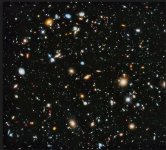I recall early on during Hubble's initial deployment that apparently deep space is obscured by the crowded forefront of objects and stars within our own galaxy. I should have said deep space rather than the Milky Way. So Scientists focused in on a small passage through which deep space can be observed.
I was wrong once before 😳
I was wrong once before 😳
No, my point was the limitations presented to Hubble and whether that will translate to the James Webb's ability as well in terms of the effective window available to see through/past. Will it be able to view deep space in all directions?
We are located half-way out on the spiral arms of the Milky Way galaxy.
If we want to see clearly into deep space we must look outwards, and not inwards towards the galactic centre.
If we want to see clearly into deep space we must look outwards, and not inwards towards the galactic centre.
... the limitations presented to Hubble ...
One limitation of Hubble is that it orbits the Earth.
Sometimes, targets that astronomers would like Hubble to observe are obstructed by the Earth itself as Hubble orbits. This can limit the time spent observing a given object.
The James Webb Space Telescope, because it doesn't orbit the Earth, will have an unobstructed view of the Universe.
The Hubble deep field is the size of Roosevelt's eye on a dime at arm's length. Not sure if you're not understanding my query or just obfuscating. 

Gale, the deep field image is approx 1mm square at arms length. So all those galaxies in the image are what was captured by a Hubble in that tiny area.
Well it was presented as a "limitation" by the scientific community.
you clearly know better.
However the question remains unanswered. Must be moot.
you clearly know better.
However the question remains unanswered. Must be moot.
I clearly don't understand the question! Please give me a reference to what the scientific community has to say about this "effective window".
What I have managed to discover is that the different instruments on the Hubble have different fields of view.
(The field of view is the area of the sky an instrument can observe at any given time.)
The primary near-infrared camera of the JWST has a field of view of 2.2 x 2.2 arcminutes which is comparable to the 2.7 x 2.7 arcminutes of the the Hubble wide field camera 3.
(The diameter of the full moon as seen from Earth is 31 arcminutes.)
What I have managed to discover is that the different instruments on the Hubble have different fields of view.
(The field of view is the area of the sky an instrument can observe at any given time.)
The primary near-infrared camera of the JWST has a field of view of 2.2 x 2.2 arcminutes which is comparable to the 2.7 x 2.7 arcminutes of the the Hubble wide field camera 3.
(The diameter of the full moon as seen from Earth is 31 arcminutes.)
It seems obvious to me that neither telescope can see through walls, so I don't see what all the fuss is about!
P.S. Infrared light can penetrate cosmic dust better than visible light. Hence the JWST is less limited in its ability to see through cosmic dust and hence will see further into the universe than Hubble.
P.S. Infrared light can penetrate cosmic dust better than visible light. Hence the JWST is less limited in its ability to see through cosmic dust and hence will see further into the universe than Hubble.
I was wondering that because the jwst will be farther out in space whether it might have more potential vantage points to peer through. I suppose we've yet to find out.
I was wondering that because the jwst will be farther out in space whether it might have more potential vantage points to peer through.
As Webb rotates, it will have access to the entire sky!
https://stsci-opo.org/STScI-01EVS3NC47DJQ8CS3T2VQAQ8KX.mp4
The above video is a 'must see'! It reveals an absolutely fantastic piece of engineering and should answer your questions, Pete!
Not so much thanks to its position but rather the ability in its instrumentation as I understand it. But being cool seem to help also 😉I was wondering that because the jwst will be farther out in space whether it might have more potential vantage points to peer through. I suppose we've yet to find out.
//
Not so much thanks to its position...
I recommend you check out the video.
- Status
- Not open for further replies.
- Home
- Member Areas
- The Lounge
- What is the Universe expanding into..
